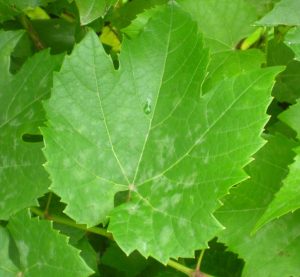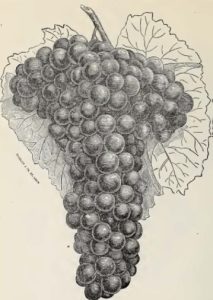Published on
Updated on
Contents:
- Misunderstanding Weather Events and Grape Disease Threats
- Japanese Beetles Reported Rrom Around the State This Week
- Drought and Grapevine Trunk Disease
- Future Grape Cultivars for the Missouri Grape and Wine Industry
- Report Herbicide Drift Damage to Grape Crop to Missouri Department of Agriculture
- Cumulative Growing Degree Days for the Seven Grape Growing Regions of Missouri from April 1 to June 12, 2023
Misunderstanding Weather Events and Grape Disease Threats

Photo credit: Dean S. Volenberg.
Dry weather (drought) coupled with low soil moisture can often lead to a misunderstanding of potential disease threats. When dry conditions prevail the main disease that can cause infection is powdery mildew. Powdery mildew (Figure 1) does not need free water (wet green tissue) to cause an infection. In contrast, the other main grape diseases, black rot, anthracnose, Phomopsis, and downy mildew all need free water (wet green tissue) in order to cause infection.
A good way to remember this information is to think about the main disease threat in the western states of Washington, Oregon, and California. In these states, dry environments are common and so is the threat of infection from powdery mildew.
Although powdery mildew does not need wet green tissue to cause infection, powdery mildew prefers high relative humidity. High relative humidity conditions persist within the grape canopy. Within the grape canopy a layer of leaves provides shade, gas exchange is occurring in the leaves and morning dew persists longer compared to the outer leaves. Therefore, when scouting for powdery mildew observe leaves within the canopy interior. These interior leaves are protected from UV-light, which is detrimental to powdery mildew. Check both the top and bottom of the leaves for infection.
A number of products are available for managing powdery mildew. Check the 2023-2024 Midwest Fruit Pest Management Guide. Although sulfur applications can be used to prevent powdery mildew infections, be sure you are aware of which grape cultivars are sensitive to sulfur (Table 1).
Table 1. Commonly Grown Grape Cultivars in Missouri that are moderately or highly susceptible to Powdery mildew Erysiphe nectar and sensitivity to foliar sulfur spray applications
| Cultivar/Species | Susceptible to powdery mildew | Sulfur sensitivity | ||
|---|---|---|---|---|
| Cabernet Franc | Highly susceptible | No | ||
| Catawba | Moderately susceptible | No | ||
| Chambourcin | Highly susceptible | Yes | ||
| Chardonel | Highly susceptible | No | ||
| Concord | Moderately susceptible | Yes | ||
| Norton | Moderately susceptible | Yes | ||
| Seyval | Highly susceptible | No | ||
| St. Vincent | Moderately susceptible | No | ||
| Traminette | Moderately susceptible | No | ||
| Valvin muscat | Moderately susceptible | No | ||
| Vincent | Moderately susceptible | Unknown | ||
| Vidal blanc | Highly susceptible | No | ||
| Vignoles | Highly susceptible | No | ||
| Vitis vinifera | Highly susceptible | 1No | ||
1Be aware there are some exceptions when it comes to Vitis vinifera cultivars, as some cultivars are sensitive to foliar sulfur applications.
Japanese Beetles Reported Rrom Around the State This Week
Grape growers spotted Japanese beetles within their vineyards. The migrating front of beetles moving east to west has put the heaviest Japanese beetle population on the western side of the state. In areas experiencing dry soil conditions, adult beetle emergence likely will be limited. On the other hand, areas near Kansas City that have have experienced frequent rainfall events may see more explosive adult beetle emergence. Keep scouting and be prepared if Japanese beetle populations begin to increase. For non-bearing grapevines, do not let damage from Japanese beetles get out of control.
Drought and Grapevine Trunk Disease
One of the main grapevine abiotic stresses is dry soil conditions brought on by drought. Lack of water causing grapevine stress has been shown to start the progression of grapevine trunk diseases. GTD are fungal organisms that live a portion of their life within the grapevine. These fungal organism are known as endophytes and remain harmless to the grapevine until triggered to become pathogenic. Although there have been a small number of triggers identified, water stress of grapevines is considered a main trigger.
Newly established vineyards should be adequately watered during times of drought to reduce the potential development of GTD. The past few years the springtime weather provided adequate rainfall for planting and early grapevine establishment. The springtime weather of 2023 has been extremely dry and was proceeded by dry conditions in the fall of 2022. New vineyards established this spring should be carefully observed in future years for GTD. Attention should be given to vineyards in which known drought related stresses occurred.
Established grape bearing grapevines are also negatively impacted by drought conditions and GTD. The GTD can block the water conducting xylem and aggravate water stress. Often the impact of GTD is not readily apparent until grapevines totally collapses. A grapevine that appears healthy one day and then suddenly appears wilted the next day is experiencing apoplexy.
The extreme cold temperatures in December 2022 resulted in some trunk splitting. This splitting further reduces the grapevines vascular system. Efforts should be made to reduce water stress in vineyard blocks with damaged trunks. Additionally, these damaged grapevines will be subject to Crown gall. Consideration should be given to bringing up new shoots from the root crown to replace damaged vines in the near future.
Future Grape Cultivars for the Missouri Grape and Wine Industry

A recent main focus of my research program is to identify grape cultivars that may have potential success for the Missouri grape and wine industry. Besides evaluating readily available named cultivars and advanced grape breeder selections, I search out for named cultivars that were lost during prohibition. These cultivars were sent across the Atlantic ocean to serve as rootstocks for the European wine industry that was succumbing to root Phylloxera. Fortunately some of these cultivars still exist in France although the wine made from them is forbidden, but that is another story. Many of these lost cultivars have made there way to other countries and complicating the process have taken on new names.
Recently, the cultivar Cunningham was delivered to Foundation Plant Services in Davis California from Portugal. Historically, the Cunningham grape was from the garden of Jacob Cunningham in Prince Edward County, VA. Cunningham in part has a genetic background of Vitis aestivalis var. bourquiniana. Cunningham is late maturing grape and is used to make still wine and madeira style wines. I am hopeful that Cunningham grapevine with its V. aestivalis genetic background will have a broad tolerance to common fungal pathogens, similar to Norton.
A major focus is to identify sustainable grape cultivars for the grape industry. Grape cultivars derived from the species aestivalis are natural fit to a sustainable grape industry. Just look at the past and current success of Norton and Cynthiana. Both Norton and Cynthiana have a broad tolerance/resistance to many common fungal pathogens.
The success of the grape industry is strategic initiative driven by the recent objective of the Grape and Wine Institute’s strategic plan:
Objective E&I.2. Conduct Research to Improve Cultivars and Best Practices.
Through applied research, develop and/or identify cultivars and best practices that will produce high quality grapes that (a) are adapted to environmental change, (b) are sustainable, and (c) have potential for making wines that meet consumers’ taste preferences.
The success of this project is driven by all of us in the grape and wine industry. I call on you to bring new cultivars that may have been lost historically to my attention. You may find these lost cultivars in your readings or in your travels. Some lost American cultivars remain hidden away in far reaches of the world, simply under a new name. As an example, in Madeira, Portugal, the Cunningham grape goes by the name Canin.
Report Herbicide Drift Damage to Grape Crop to Missouri Department of Agriculture
The Missouri Department of Agriculture keeps records of reported pesticide drift incidents. Grapevines are very sensitive to synthetic auxin herbicides which includes dicamba, 2,4-D and other herbicides. The last day that herbicides containing the active ingredient dicamba can be applied to dicamba tolerant soybeans in Missouri is June 30. The environmental protection agency works with states to approve additional labeling that may further restrict dicamba use in over the top applications. The EPA approved label restrictions for dicamba in 2022 in Iowa and Minnesota. For instance, in Iowa dicamba can not be applied over the top of dicamba tolerant crops after June 20.
For more information on herbicide drift and symptoms from synthetic auxin herbicides, please see Herbicide Drift: What to do?
Cumulative Growing Degree Days for the Seven Grape Growing Regions of Missouri from April 1 to June 12, 2023
| Region | Location by County | Growing Degree Days1 | ||
|---|---|---|---|---|
| 2023 | 2022 | 30-year Average | ||
| Augusta | St. Charles | 1070 | 1001 | 994 |
| Hermann | Gasconade | 996 | 923 | 938 |
| Ozark Highland | Phelps | 1135 | 987 | 1031 |
| Ozark Mountain | Lawrence | 1083 | 987 | 1030 |
| Southeast | Ste. Genevieve | 1023 | 1011 | 1043 |
| Central | Boone | 1087 | 944 | 960 |
| Western | Ray | 1044 | 887 | 927 |
1 Growing degree days at base 50 from April 1 to June 12, 2023. Data compiled from Useful and Useable at U2U Decision Tools – Corn GDD.
To determine the number of growing degree days accumulated in your area since April 1, use this tool.
Please scout your vineyards on a regularly scheduled basis in an effort to manage problem pests. This report contains information on scouting reports from specific locations and may not reflect pest problems in your vineyard. If you would like more information on IPM in grapes, please contact Dean Volenberg at 573-882-0476 (office) 573-473-0374 (mobile) or volenbergd@missouri.edu